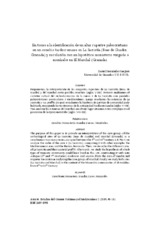En torno a la identificación de un altar rupestre paleocristiano en un cenobio tardorromano en La Sacristía (Beas de Guadix, Granada) y su relación con un hipotético monasterio visigodo o mozárabe en El Marchal (Granada)

View/
Author
Hernández San José, Daniel
Publisher
UCOPressDate
2019Subject
CenobioMonasterio
Cuevas
Mozárabes
Guadix (Granada, España)
Cenobium
Monastery
Caves
Mozarabs
METS:
Mostrar el registro METSPREMIS:
Mostrar el registro PREMISMetadata
Show full item recordAbstract
Proponemos la interpretación de los conjuntos rupestres de La Sacristía (Beas de Guadix) y del Marchal como posibles cenobios (siglos V-XII). Primero analizamos el carácter cultual del nicho-hornacina de la cueva 6 de La Sacristía con paralelos paleocristianos peninsulares y mediterráneos. Luego, reseñamos las estancias de La Sacristía y sus graffiti. Después estudiamos la hipótesis de qué tipo de comunidad pudo habitarla, recogiendo los testimonios de la Antigüedad Tardía en Guadix (siglos V-VII). Tras analizar las estancias del Marchal, en último lugar situamos estos complejos en el panorama de la época mozárabe (siglos VIII-XII). The purpose of this paper is to provide an interpretation of the cave groups of the archeological sites of La Sacristia (Beas de Guadix) and Marchal (Granada) as a cenobium or two monasteries, occupied between the 5th and 12th century A.D. First, we analyze the niche of the cave 6 (La Sacristia), comparing it with other examples the Mediterranean area and the Iberian Peninsula. Then, we describe the different caves of La Sacristia and their parietal graffiti. Afterwards, we study the hypothesis of which type of monastic community could have lived in this site, contrasting it with Late Antique (5th and 7th Centuries) evidences and sources from the area of Guadix and Hispania. We continue analyzing the cave groups of Marchal. Finally we study both sites (La Sacristia and Marchal) in the context of the Mozarabic communities of al-Andalus, from 8th to 12th Century.
